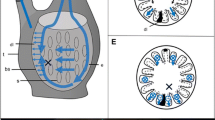Summary
The water-conducting system ofEphydatia fluviatilis includes sluice-like structures at the critical sites, some of them at the surface of the sponge and some inside it. These are dermal pores, pores in the walls of the inhalant and exhalant canals, and the osculum. The characteristic common to all of these openings is the porocyte, a disk-shaped cell with an aperture in the middle, so that it has an annular appearance.
The shape and fine structure of the cells with pores, as well as their position in the pinacocyte epithelium and the impermanence of at least the dermal pores, indicate that these cells are regular pinacocytes serving a special function.
The porocytes in the walls of the exhalant canals always appear in association with a flagellated chamber, with which they are connected by way of two or three modified choanocytes that form a double cone.
The osculum at the distal end of the egestion passage, is the product of two porocytes, derived from the exopinacocyte and the endopinacocyte epithelia and having congruent apertures.
Zusammenfassung
Das Wasserleitungssystem vonEphydatia fluviatilis ist an den entscheidenden Stellen mit Schleusen versehen, die teils an der Körperoberfläche, teils im Schwamminnern liegen. Es handelt sich hierbei um Dermalporen, um Wandporen der ein- und ausführenden Kanäle sowie um den Egestionsporus. Das übereinstimmende Merkmal aller Öffnungen ist die Porocyte, eine diskusförmige, mit einem Durchbruch versehene und somit ringförmig sich darstellende Zelle.
Die Gestalt und Feinstruktur der Zellen mit Porus, ihre Lage im jeweiligen Pinacocytenepithel und die Unbeständigkeit zumindest der Dermalporen sprechen dafür, daß es sich um reguläre Pinacocyten mit einer Sonderaufgabe handelt.
Die Porocyten in der Wandung der ausführenden Kanäle treten jeweils in Verbindung mit einer Kragengeißelkammer auf und sind mit dieser durch zwei bis drei modifizierte Choanocyten, die einen Doppelkonus bilden, verbunden.
Die Egestionsöffnung am distalen Ende des Egestionsrohres ist das Produkt zweier Porocyten, die dem Exo- und dem Endopinacocytenepithel entstammen und kongruente Durchbrüche aufweisen.
Similar content being viewed by others
Abbreviations
- A:
-
Amöbocyt
- AF:
-
Achsenfaden
- aK:
-
ausführender Kanal
- Ar:
-
Archäocyt
- B:
-
Bakterien
- Ch:
-
Choanocyt
- Co:
-
Collencyt
- D:
-
Dictyosom
- DP:
-
Dermalpore(=Pore des Pinacoderms)
- E:
-
Egestionsöffnung
- eK:
-
einführender Kanal
- EnP:
-
Endopinacocyt
- eR:
-
endoplasmatisches Retikulum
- ExP:
-
Exopinacocyt
- exV:
-
exocytierte Vakuole
- G:
-
Geißel
- GK:
-
Kragengeißelkammer
- K:
-
Kern
- Ko:
-
Kollagen
- Kr:
-
Kragen
- KZ:
-
Konuszelle
- M:
-
Mesenchym
- Mi:
-
Mitochondrium
- N:
-
Nadel
- NV:
-
Nahrungsvakuole
- OR:
-
Oskularrohr
- PD:
-
Pinacoderm
- pV:
-
pulsierende Vakuole
- Py:
-
Pyle
- PZ:
-
Porenzelle
- Sk:
-
Skleroblast
- SR:
-
Subdermalraum
- ZK:
-
Zellkontakt
Literatur
Bagby, R.: The fine structure of pinacocytes in the marine spongeMicrociona prolifera (Ellis and Solander). Z. Zellforsch. Mikrosk. Anat.105, 579–594 (1970)
Brien, P.: Contribution à l'étude de la régéneration naturelle chez les Spongillidae,Spongilla lacustris, Ephydatia fluviatilis. Arch, de Zool. Expér. Gén.74, 461–506 (1932)
Bullock, T.H.: Protozoa, Mesozoa and Porifera. V. Porifera. In: Structure and Function in the Nervous System of Invertebrates I. (T.H. Bullock, G.H. Horridge, eds.), pp. 450–457. San Francisco-London: W.H. Freeman and Comp. 1965
Connes, R., Diaz, J.P., Paris, J.: Choanocytes et cellule centrale chez la DémospongeSuberites massa Nardo. C. R. Acad. Sc. Paris273, 1590–1593 (1971)
Feige, W.: Die Feinstruktur der Epithelien vonEphydatia fluviatilis. Zool. Jahrb. Abt. Anat. Ontog. Tiere86, 177–237 (1969)
Jones, W.C.: The structure of the porocytes in the calcareous spongeLeucosolenia complicata (Montagu). J. Roy. Microsc. Soc.85, 53–62 (1965)
Karnovsky, M.J.: A formaldehyde-glutaraldehyde fixative of high osmolality for use in electron microscopy. J. Cell Biol.27, 137A-138A (1965)
Kilian, E.F.: Wasserströmung und Nahrungsaufnahme beim SüßwasserschwammEphydatia fluviatilis. Z. Vgl. Physiol.34, 407–147 (1952)
Kilian, E.F., Wintermann-Kilian, G.: Cilien und „Epithelringe“ beiEphydatia fluviatilis. Naturwissenschaften56, 222 (1969)
Ledger, P.W.: Septate junctions in the calcareous spongeSycon ciliatum. Tissue Cell7, 13–18 (1975)
Revel, J.P.: Fine structure of intercellular contacts in the spongeMicrociona prolifera. Biol. Bull. Mar. Biol. Lab.131, 402 (1966)
Weissenfels, N.: Bau und Funktion des SüßwasserschwammsEphydatia fluviatilis. I. Das Nephridialsystem der Pinacocyten. Cytobiologie Z. Exp. Zellforsch.8, 269–288 (1974)
Weissenfels, N.: Bau und Funktion des SüßwasserschwammsEphydatia fluviatilis L. (Porifera). II. Anmerkungen zum Körperbau. Z. Morphol. Tiere81, 241–256 (1975)
Weissenfels, N.: Bau und Funktion des SüßwasserschwammsEphydatia fluviatilis L. (Porifera). III. Nahrungsaufnahme, Verdauung und Defäkation. Zoomorphologie85, 73–88 (1976)
Weissenfels, N.: Bau und Funktion des SüßwasserschwammsEphydatia fluviatilis L. (Porifera). V. Das Nadelskelet und seine Entstehung. Zool. Jahrb. Abt. Anat. Ontog. Tiere99, 211–223 (1978)
Weissenfels, N., Landschoff, H.W.: Bau und Funktion des SüßwasserschwammsEphydatia fluviatilis L. (Porifera). IV. Die Entwicklung der monaxialen SiO2-Nadeln in Sandwich-Kulturen. Zool. Jahrb. Abt. Anat. Ontog. Tiere98, 355–371 (1977)
Wintermann, G.: Entwicklungsphysiologische Untersuchungen an Süßwasserschwämmen. Zool. Jahrb. Abt. Anat. Ontog. Tiere71, 427–486 (1951)
Wintermann-Kilian, G., Kilian, E.F., Ankel, W.E.: Musterbildung und Entwicklungsphysiologie der Epithelien beim SüßwasserschwammEphydatia fluviatilis. Zool. Jahrb. Abt. Anat. Ontog. Tiere86, 459–492 (1969)
Author information
Authors and Affiliations
Rights and permissions
About this article
Cite this article
Weissenfels, N. Bau und Funktion des SüßwasserschwammsEphydatia fluviatilis L. (Porifera). Zoomorphologie 95, 27–40 (1980). https://doi.org/10.1007/BF01342232
Received:
Issue Date:
DOI: https://doi.org/10.1007/BF01342232




